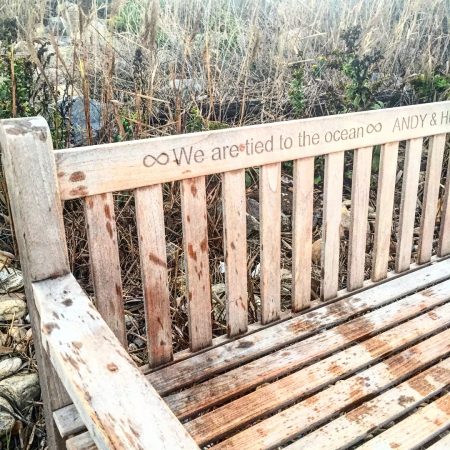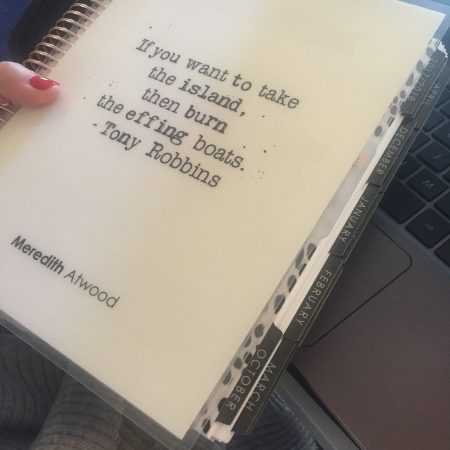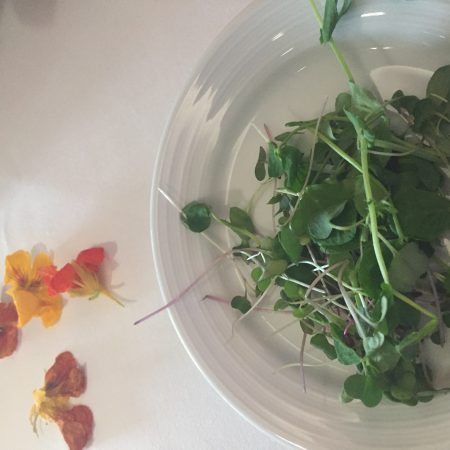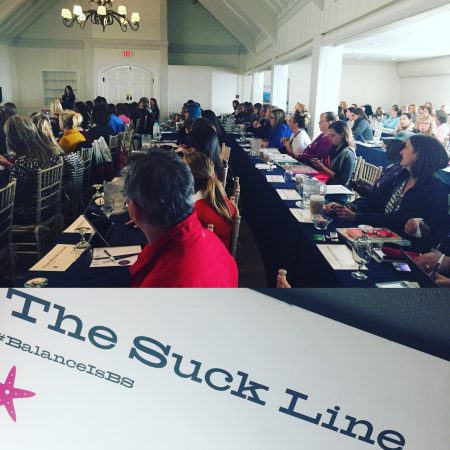Last night before the kids went to bed, the Expert made a bargain with our daughter–age almost-nine. She had a math assignment to complete–which by the way, she totally fibbed about completing–and he bargained that she could do it in the morning.
As the Expert left the house this morning (after making lunches–I will give credit where credit is due), the girl child had not completed her math.
There I stood: The Mean Mom Math Machine.
Needless to say, the morning took a quick detour from calm to crazy–a far cry from Friday morning. (I had even done some meditation and writing this morning, y’all. I am in this shiznit.)
I will admit, I sent the Expert a snarky text. (Something about don’t make bargains and leave me to execute. Whoops.) But right after I fired that off, I made a note of how quickly things can begin to unravel, to feel like too much, to feel like I am drowning.
And I wasn’t helping anything.
“We can change our state in an instance,” which is Tony Robbins’ big point–change your state of mind before you walk on hot coals (cool moss, yes, yes yes), and and it’s not a big deal.
Changing a state from fearful to powerful, also means that it can go the other way. We can change our state from good to bad, okay to poop, and on and on.
I am quick to go downhill. I am working so hard to stop doing that. It’s something that’s making me nuts, and I know that it’s also a choice.
Mike Reilly says on race day the only thing we can control is our attitude.
Maya Angelou is quoted as saying, “If you don’t like something, change it. If you can’t change it, change your attitude.”
Attitude: it’s a thing.
I find that many of us are being crushed by the expectations in our lives–parenthood, partnership, work, fitness, body image–whether these expectations are from other people or ourselves. The expectations are HUGE.
Then the overarching theme of our internal voice can become: “I am drowning. I am suffocating. There is seriously no way out of this.”
I feel that way too, sometimes, that I am drowning, suffocating. I feel that the expectations of my world are just too great. I feel that there is no humanly possible way to get all the things done, to take care of my family, to pursue my dreams, to set goals, to eat healthy, to work out (let alone train for a big race these days)…
You know what?
I am right. I am 100% correct—if I feel those things to be true.
I am right–if that is what I believe.
When I start to feel I am drowning, I stop, drop and roll–in a way.
I stop.
And I assess and adjust TWO Things.
Of course, I don’t have everything figured out… but if I can get a hold of myself and my expectations before I dig myself a deep hole or float out to sea, it sure is easier to deal with.

I Change My Perspective
When I am suffocating, I write something, anything. I take action to move the ping-ponging thoughts out of my head, and onto paper.
This isn’t just for writers, either. This is for anyone. I may take out pen and paper and make a list. I may list some things I am grateful for. I may scribble how I am mad.
I may write a haiku. Seriously. If you are furious, try writing a haiku about how mad you are.
(For those who need a refresher: 3 lines / the first and last lines have 5 syllables / middle line has 7 syllables. Usually don’t rhyme.)
Today is great crap.
All people suck really bad.
Great misery me.
Okay, so that might not be helpful, but it will keep your mind busy for a minute.
Getting something on paper often helps me to breathe.
Lorna K. Bailey just launched her new website about planners and planning. I subscribed to her newsletter, and appreciated some of her anecdotes about the purpose of the Planner. I have dabbled in planners for decades, and I realized that my life is better when I have a physical notebook where I can see my lists, my desires, my dreams. Reading her lists helped me realize that I needed this as a part of my life.
For so long, I thought, I don’t want to transfer my massive Google calendar–which is constantly changing–to paper.


But the planner can be whatever you want. (Who knew).
I am using mine to plan out only a day or so in advance. I take the evening before or the morning of, and plan just the next day–or even just a few hours. I look at my giant electronic calendar and on the paper calendar, I simply block off the times that I am not available…
What is left? Well, I see white space.
To me, the white space is all about abundance.
“Abundance is a process of letting go;
that which is empty can receive.” Bryant H. McGill
Within this white space, I find space where I can breathe. Mentally seeing the breathing space–means that breathing space actually exists.
Some days, the white space is only a few minutes. But it’s there. And I know that if there is a little white space, I can find time to do something I need (and more importantly, want) to do.
Something as simple as a planner, some morning deep breaths (that’s all I am doing—15-20 deep breaths), or a list of gratitude and anxiety (also part of my morning) is a vehicle for changing perspective.
We can change where we are–at any given moment.
We can physically move (we are not trees). We can mentally adjust (think of something funny, read a story). We can wash away some anxiety (with a series of breaths). We can clear our heads with some calming music (Devi Prayer Sacred Chants Of Devi–and I go to that when I need some grounding).


I Use The Suck Line
I am guilty of piling more and more things into my schedule, my life, and my head.
A simple solution?
“Pick the one important thing,” people will say.
But I have 120 important things! I want to scream. And I think most people do, too.
Here’s where we must do. We must distinguish our “things”–what is a PRIORITY, and what is a TASK?
Priorities are super important. Goes sort of without saying, right?
Priorities are the things we look back on our lives and say, “I really did amazing with _____.” (Writing that book, caring for my kids, getting that job I loved, loving my spouse).
Priorities are what matter deepest and truest to our hearts, souls and lives. And priories vary from person to person.
Tasks are things we must do in order to not be featured on Hoarders.
Choosing that “one thing” is a luxury (and an impossibility) in most cases of people with families, work and more. We don’t have the luxury to pick “the one thing,” unless we are in a really unique state where someone else is pulling all the weight.
“You can have virtually anything you want,
but you can’t have everything you want.”
– Ray Dalio
Another way to translate: anything is possible if you are willing to pay the price.
When I give talks about “The Suck Line,” I emphasize how we can have goals and dreams–and within those goals and dreams–one of them might mean “everything” to us (writing that book, finishing that IRONMAN, losing that weight).
But on top of those dreams, we also other priorities (still important) that we must recognizes and nurture. And we have the tasks (necessities to handle).
All things must be handled, somehow. (Hence the suffocating feeling).
Yes, our life list is long. So we must learn to rotate things around, to give the illusion of balance. Because balance is a fallacy–or as I like to say, “Balance is BS.”
Choosing our TOP PRIORITIES is vital.
The pressure to pick the “one thing” is often way too great—so making a list of our top (10? 12? 15?) priorities is a nice compromise. (This is also where the Planner becomes a handy tool, too.)
The rest of the things in life (the tasks) can fall below the Suck Line and rotate along, accordingly.


The Suck Line is a method I created that forces us to identify our top LIFE priorities
… (example: raising our kids, loving our family, work, our next big goal, finishing that IRONMAN, graduating from school)
… then we identify our tasks (laundry, cooking, cleaning, doctor’s appointments–which are all part of life)
… but then we then draw a line in the sand–this is the Suck Line.
Everything above Suck Line we tend to, we keep important. We don’t let our kids or our family be neglected. We don’t give up on our dreams. We keep those things top priorities in our hearts, mind and actions.
The tasks and minutiae, however, can fall below the line and get neglected for a bit.
What is going to really happen if we don’t do the laundry for four days? Or a week? Will people die? Nope.
We need not neglect the laundry forever. But we can let it go for a period of time–to make more room for those things that really matter. Then, when the laundry is crazy, we rotate it back above the line for a time–tend to it–and then allow it to fall off again.
The SUCK LINE is a method that can make our lives actually work.
When we start to feel that we are drowning, let a TASK go. Keep the PRIORITIES, and let several of these tasks slide for the time being.
The Suck Line is actually “one thing” that can often make a massive difference.
Ready for some holiday shopping?
All the new, pretty things are ready for you at Tri Fe Tri.


The suck line is a revelation…..I read about it in one of your earlier blogs and I use it all the time now. It makes life manageable (and keeps us off ‘Hoarders’ – just – that made me laugh so much!). Thank you for sharing and keeping it real!